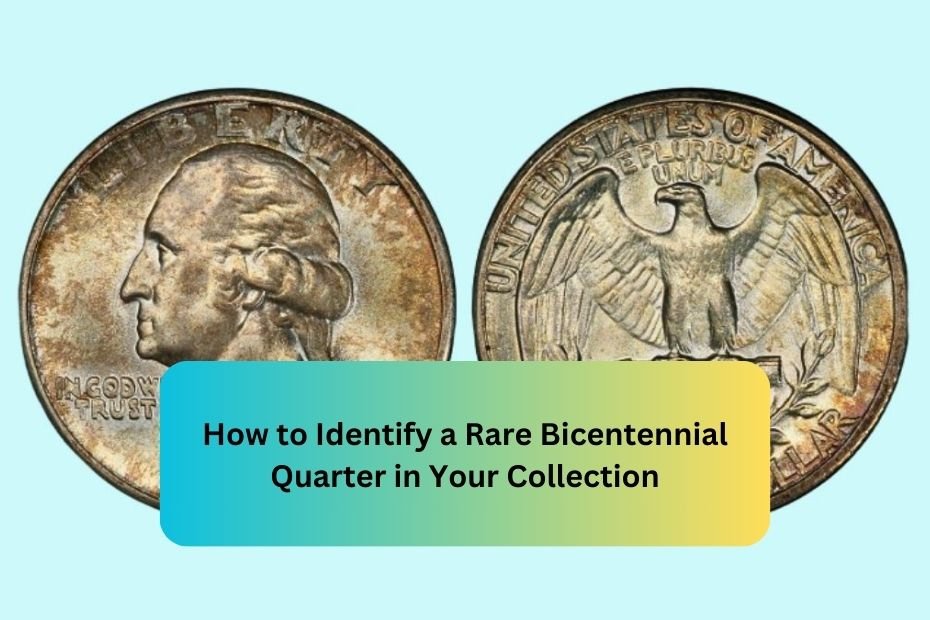The Bicentennial Quarter, issued in 1975 and 1976, celebrates the 200th anniversary of American independence. Although millions of these coins were minted, certain rare variations can significantly enhance their value to collectors. Identifying a rare Bicentennial Quarter in your collection can be an exciting endeavor. This guide will walk you through the process of spotting rare editions, understanding their features, and assessing their potential worth.
1. Understanding the Bicentennial Quarter
The Bicentennial Quarter features a unique design that distinguishes it from regular quarters. Here are some key details:
- Design: The obverse (front) of the coin depicts a portrait of George Washington, while the reverse (back) showcases a drum, an eagle, and the inscription “1776–1976.” This design was created to commemorate the United States’ 200th anniversary.
- Minting Years: The quarter was minted in 1975 and 1976, but the design was used only for the two years, unlike regular quarters that are minted every year.
- Mintage: A total of about 1.6 billion Bicentennial Quarters were produced, which might make them seem common. However, certain variations and conditions can make some examples highly sought after by collectors.
2. Identifying Rare Variants
While many Bicentennial Quarters may appear similar at first glance, certain rare variants can be found. Here are the most notable:
a. Silver Clad Bicentennial Quarters
- Minted at: The San Francisco Mint, the special silver-clad versions were issued for collectors.
- Composition: These coins contain 40% silver, giving them intrinsic value beyond face value. They were sold in proof sets.
- How to Identify: Check for a “S” mintmark located below the “In God We Trust” inscription on the obverse. Regular quarters minted for circulation have a “D” (Denver) or “P” (Philadelphia) mintmark or none at all.
b. Double Die Obverse Variations
- Description: Some Bicentennial Quarters have a noticeable doubling effect on the inscriptions and features of George Washington’s portrait.
- How to Identify: Inspect the coin closely under a magnifying glass or jeweler’s loupe. Look for doubled lettering and details on the obverse. The most notable area is usually around “In God We Trust.”
c. Other Mint Errors
- Various Errors: Minting errors can include off-center strikes, wrong planchet errors, and missing mintmarks.
- How to Identify: Examine your coins thoroughly. Errors can be subtle or pronounced, so a careful inspection is key.
3. Assessing the Condition of Your Coins
The condition of the coin, known as its grade, plays a significant role in its value. Here’s how to evaluate the condition of your Bicentennial Quarters:
a. Coin Grading Scale
Coins are graded on a scale from 1 to 70, with higher numbers indicating better condition. Familiarize yourself with the grading categories:
- Good (G): Heavily worn with minimal details visible.
- Very Good (VG): Some details are visible, but the coin is worn.
- Fine (F): Moderate wear; most details are clear.
- Very Fine (VF): Slightly worn, with clear details and moderate luster.
- Extremely Fine (EF): Minimal wear; details are sharp, with some luster remaining.
- Uncirculated (MS): No signs of wear; the coin has its original luster.
b. Visual Inspection
- Look for Wear: Check for wear on the high points of the coin, such as Washington’s hair, the rim, and the lettering.
- Examine Luster: Uncirculated coins have a bright, shiny appearance, while circulated coins may appear dull or muted.
- Check for Cleaning: Avoid coins that have been harshly cleaned, as this can diminish their value.
4. Using Tools for Assessment
To accurately identify and evaluate your Bicentennial Quarters, consider using the following tools:
- Magnifying Glass or Loupe: For close inspections of details, mintmarks, and potential errors.
- Digital Scale: To weigh your coins; the weight can help determine if it’s a regular clad quarter or a silver variant.
- Coin Grading Guide: Reference guides provide visual aids for grading coins based on images and descriptions.
5. Researching Market Value
Once you’ve identified a potential rare Bicentennial Quarter, it’s essential to research its market value. Here are some steps to do this effectively:
a. Consult Price Guides
Check reputable coin price guides or online resources to get an idea of current market prices. Websites like the Professional Coin Grading Service (PCGS) and Numismatic Guaranty Corporation (NGC) offer valuable information on coin values.
b. Review Auction Results
Look at recent auction results to see what collectors have paid for similar coins. This can give you a realistic sense of the value of your quarter.
c. Join Coin Collecting Forums
Participating in coin collecting communities can provide insights from experienced collectors. Websites and forums allow you to ask questions and share photos for feedback on your coins.
6. Selling or Trading Your Rare Quarter
If you believe you’ve identified a valuable Bicentennial Quarter, you may be considering selling or trading it. Here are some tips for this process:
a. Get Professional Appraisal
Consider having your coin professionally appraised, especially if you believe it’s significantly valuable. A reputable numismatist can provide an accurate assessment and help you understand your options.
b. Choose the Right Marketplace
You can sell your coin through various channels, including online marketplaces, coin shows, or local coin shops. Choose the method that you feel most comfortable with and that aligns with the coin’s value.
c. Consider Grading Services
If your coin is particularly valuable, consider submitting it to a grading service for professional grading and encapsulation. A graded coin can often fetch a higher price in the market.
Conclusion
Identifying a rare Bicentennial Quarter in your collection can be an exciting journey filled with discovery. By understanding the unique features of these coins, recognizing the rare variants, assessing their condition, and researching their market value, you can increase your chances of finding a valuable piece.
Always remember to handle your coins with care, and enjoy the process of building and exploring your collection. Whether you choose to keep your rare finds or share them with fellow collectors, the world of coin collecting offers a fascinating glimpse into history and craftsmanship.
FAQs
- What are the key features of a Bicentennial Quarter?
The Bicentennial Quarter features a unique reverse design commemorating the 200th anniversary of American independence and is minted in 1975 and 1976. - How can I tell if my Bicentennial Quarter is silver?
Look for an “S” mintmark on the obverse, which indicates it was minted in San Francisco. Silver-clad quarters contain 40% silver and were sold in proof sets. - What should I do if I find a rare mint error?
Document the error with clear photos, and consider consulting with a professional numismatist for an appraisal and advice on how to sell or trade it. - How can I maintain the value of my coin collection?
Store your coins in protective holders, avoid cleaning them, and keep them in a cool, dry environment to prevent damage. - Where can I find more information about coin collecting?
Online resources, local coin clubs, and numismatic societies are excellent places to learn more about coin collecting and to connect with fellow enthusiasts.

